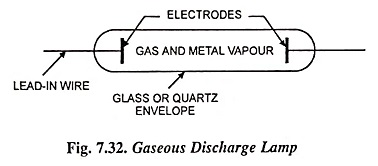Gaseous Discharge Lamp – Working Principle and Types:
Incandescent lamp suffers from two disadvantages—low efficiency and coloured light. The gaseous discharge lamp have been developed to overcome these drawbacks.
The basic principle of a gaseous discharge lamp is illustrated in Fig. 7.32. Gases are normally poor conductors, specially at atmospheric and higher pressures, but application of suitable voltage, called the ignition voltage, across the two electrodes can result in a discharge through the gas, which is accompanied by electromagnetic radiation. The wavelength of this radiation depends upon the gas, its pressure, and the metal vapour used in lamp. Argon gas and sodium and mercury vapours are commonly employed in the manufacture of gaseous discharge lamps.
Once the ionisation has commenced in the gas, it has a tendency to increase continuously accompanied by a fall in the circuit resistance, i.e., gaseous discharge lamp possesses a negative resistance characteristic. In order to limit the current to a safe value use of a choke or a ballast is made. The choke performs the dual functions of providing the ignition voltage initially, and limiting the current subsequently. Since due to use of choke the power factor becomes poor (0.3-0.4), therefore, in order to improve the power factor of the gaseous discharge lamp use of a condenser is made. The light spectrum obtained is, however, discontinuous (i.e., it consists of one or more coloured lines). The colour of the light obtained depends upon the nature of the gas or vapour used.
Discharge lamps are of two types:
- Those which give the light of the same colour as produced by the discharge through the gas or vapour such as sodium vapour, mercury vapour and neon gas lamps.
- Those which use the phenomenon of fluorescence and are known as fluorescent lamps. In these lamps, the discharge through the vapour produces ultraviolet waves which cause fluorescence in certain materials called as phosphors. The inside of a fluorescent lamp is coated with a phosphor which absorbs invisible ultraviolet rays and radiates visible rays. Example is fluorescent mercury vapour tube.
The gaseous discharge lamps are, in general, considered superior to metal filament lamps. However, they suffer from the following drawbacks:
- High initial cost and poor power factor.
- Starting is somewhat complicated requiring starters in some cases and transformer in others.
- These take time to attain full brilliancy.
- Ballasts are necessary for stabilising the current since such lamps have negative resistance characteristic.
- Light output fluctuates at twice the supply frequency. The flicker causes stroboscopic effect.
- These lamps can be used only in particular position.
